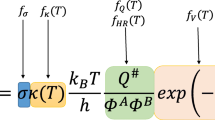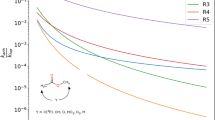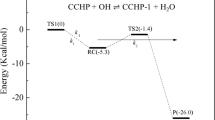Abstract
Hydrogen abstraction reaction from polycyclic aromatic hydrocarbons (PAHs) is an important reaction class for PAHs consumption and soot formation. In this work, the reaction kinetics for a series of PAHs containing up to seven aromatic rings by vinyl radical are systematically investigated using the M06-2X/cc-pVTZ method. Based on the electronic structure calculations, the rate constants of title reactions are calculated by using transition state theory coupled with Eckart tunneling correction at the temperature range of 500–2500 K. The effects of PAH sizes, structures, and reaction sites on the rate constants are examined. The results show that the PAH sizes and reaction sites have little effect on the rate constants, while the structures of PAHs influence the rate constant significantly. Hence, the hydrogen abstraction reactions are simplified into C5 and C6 reaction classes depending on the abstraction site on the five- or six-membered ring. The simple two classes are conducive to construct the combustion model of PAHs. The reactivity with C6 class possesses the higher activity than the C5 class. Moreover, the difference in rate constants between the two classes is large at low temperatures while the two reaction classes are competitive above 1000 K. The rate rules are summarized by taking the average values of rate constants of a representative set of reactions in each class, which are applicable for the chemical model construction of PAHs.






Similar content being viewed by others
References
Glassman I, Yetter RA, Glumac NG (2015) Combustion. Academic, San Diego
Violi A, D’Anna A, D’Alessio A (1999) Modeling of particulate formation in combustion and pyrolysis. Chem Eng Sci 54:3433–3442
Raj A, da Silva GR, Chung SH (2012) Reaction mechanism for the free-edge oxidation of soot by O2. Combust Flame 159:3423–3436
Richter H, Howard JB (2000) Formation of polycyclic aromatic hydrocarbons and their growth to soot—a review of chemical reaction pathways. Prog Energy Combust Sci 26:565–608
Kuwana K, Li T, Saito K (2006) Gas-phase reactions during CVD synthesis of carbon nanotubes: insights via numerical experiments. Chem Eng Sci 61:6718–6726
Saha B, Irle S, Morokuma K (2010) Formation mechanism of polycyclic aromatic hydrocarbons in benzene combustion: quantum chemical molecular dynamics simulations. J Chem Phys 132:224–303
Frenklach M, Wang H (1991) Detailed modeling of soot particle nucleation and growth. Symp Int Combust 23:1559–1566
Johansson KO, Gabaly FEI, Schrader PE, Campbell MF, Michelsen HA (2017) Evolution of maturity levels of the particle surface and bulk during soot growth and oxidation in a flame. Aerosol Sci Technol Sci 51:1333–1344
Frenklach M (2002) Reaction mechanism of soot formation in flames. Phys Chem Chem Phys 4:2028–2037
Semenikhin AS, Savchenkova AS, Chechet IV, Matveev SG, Liu Z, Frenklach M, Mebel AM (2017) Rate constants for H abstraction from benzo(a)pyrene and chrysene: a theoretical study. Phys Chem Chem Phys 19:25401–25413
Mai TVT, Ratkiewicz A, Le A, Duong M, Truong TN, Huynh LK (2018) On-the-fly kinetics of hydrogen abstraction from polycyclic aromatic hydrocarbons by methyl/ethyl radicals. Phys Chem Chem Phys 20:23578–23592
Baradyn M, Ratkiewicz A (2019) Kinetics of the hydrogen abstraction PAH + ·OH → PAH radical + H2O reaction class: an application of the reaction class transition state theory (RC-TST) and structure–activity relationship (SAR). J Phys Chem A 123:750–763
Hou DY, You XQ (2017) Reaction kinetics of hydrogen abstraction from polycyclic aromatic hydrocarbons by H atoms. Phys Chem Chem Phys 19:30772–30780
Frenklach M, Liu Z, Singh RI, Galimova GR, Azyazov VN, Mebel AM (2018) Detailed, sterically-resolved modeling of soot oxidation: role of O atoms, interplay with particle nanostructure, and emergence of inner particle burning. Combust Flame 188:284–306
Battin-Leclerc F, Curran H, Faravelli T, Glaude PA (2013) Specificities related to detailed kinetic models for the combustion of oxygenated fuels components. In: Battin-Leclerc F, Simmie J, Blurock E (eds) Cleaner Combustion. Green Energy and Technology, Springer, London
Tokmakov IV, Lin MC (2004) Combined quantum chemical/RRKM-ME computational study of the phenyl + ethylene, vinyl + benzene, and H + styrene reactions. J Phys Chem A 108:9697–9714
Bensabath T, Monnier H, Glaude PA (2016) Detailed kinetic modeling of the formation of toxic polycyclic aromatic hydrocarbons (PAHs) coming from pyrolysis in low-pressure gas carburizing conditions. J Anal Appl Pyrol 122:342–354
Norinaga K, Deutschmann O, Saegusa N, Hayashi JI (2009) Analysis of pyrolysis products from light hydrocarbons and kinetic modeling for growth of polycyclic aromatic hydrocarbons with detailed chemistry. J Anal Appl Pyrol 86:148–160
Buras ZJ, Chu TC, Jamal A, Yee NW, Middaugh JE, Green WH (2018) Phenyl radical + propene: a prototypical reaction surface for aromatic-catalyzed 1,2-hydrogen-migration and subsequent resonance-stabilized radical formation. Phys Chem Chem Phys 20:13191–13214
Whitesides R, Frenklach M (2010) Detailed kinetic Monte Carlo simulations of graphene-edge growth. J Phys Chem A 114:689–703
Whitesides R, Frenklach M (2015) Effect of reaction kinetics on graphene-edge morphology and composition. Z Phys Chem 229:597–614
Colket M, Edwards T, Williams S, Cernansky NP, Miller DL, Egolfopoulos F, Lindstedt P, Seshadri K, Dryer FL, Law CK, Friend D, Lenhert DB, Pitsch H, Sarofim A, Smooke M, Tsang W (2007) Development of an experimental database and kinetic models for surrogate jet fuels. AIAA J 770
Frenklach M, Clary DW, Gardiner WC, Stein SE (1985) Detailed kinetic modeling of soot formation in shock-tube pyrolysis of acetylene. In: Symposium (international) on combustion, vol 20, pp 887–901
Miller JA, Klippenstein SJ, Robertson SH (2000) A theoretical analysis of the reaction between vinyl and acetylene: quantum chemistry and solution of the master equation. J Phys Chem 104:7525–7536
Striebel F, Jusinski LE, Fahr A, Halpern J, Klippenstein S, Taatjes CA (2004) Kinetics of the reaction of vinyl radicals with NO: ab initio theory, master equation predictions, and laser absorption measurements. Phys Chem Chem Phys 6:2216–2223
Lifshitz A, Tamburu C, Dubnikova F (2008) Reactions of 1-naphthyl radicals with ethylene. Single pulse shock tube experiments, quantum chemical, transition state theory, and multiwell calculations. J Phys Chem A 112:925–933
Truhlar DG (1998) Basis-set extrapolation. Chem Phys Lett 294:45–48
Halkier A, Helgaker T, Jørgensen P, Klopper W, Olsen J (1999) Basis-set convergence of the energy in molecular Hartree–Fock calculations. Chem Phys Lett 302:437–446
De Lara-Castells MP, Krems RV, Buchachenko AA, Delgado-Barrio G, Villarreal P (2001) Complete basis set extrapolation limit for electronic structure calculations: energetic and nonenergetic properties of HeBr and HeBr 2 van der Waals dimmers. J Chem Phys 115:10438–10449
Huh SB, Lee JS (2003) Basis set and correlation dependent extrapolation of correlation energy. J Chem Phys 118:3035–3042
Villano SM, Huynh LK, Caestensen HH, Dean AM (2011) High-pressure rate rules for alkyl + O2 reactions. 1. The dissociation, concerted elimination, and isomerization channels of the alkyl peroxy radical. J Phys Chem A 115:13425–13442
Villano SM, Huynh LK, Caestensen HH, Dean AM (2012) High-pressure rate rules for alkyl + O2 reactions. 2. The isomerization, cyclic ether formation, and β-scission reactions of hydroperoxy alkyl radicals. J Phys Chem A 116:5068–5089
Miyoshi A (2011) Systematic computational study on the unimolecular reactions of alkylperoxy (RO2), hydroperoxyalkyl (QOOH), and hydroperoxyalkylperoxy (O2QOOH) radicals. J Phys Chem A 115:3301–3325
Yao Q, Sun XH, Li ZR, Chen FF, Li XY (2017) Pressure-dependent rate rules for intramolecular H-migration reactions of hydroperoxyalkylperoxy radicals in low temperature. J Phys Chem A 121:3001–3018
Sun XH, Zong WG, Wang JB, Li ZR, Li XY (2019) Pressure-dependent rate rules for cycloaddition, intramolecular H-shift, and concerted elimination reactions of alkenyl peroxy radicals at low temperature. Phys Chem Chem Phys 21:10693–10705
Sun XH, Zong WG, Li ZR, Li XY (2019) Pressure-dependent rate rules for the intramolecular H-shift reactions of hydroperoxy-alkenyl-peroxy radicals in low temperature. Energy Fuels 33:5597–5609
Frisch MJ, Trucks GW, Schlegel HB, Scuseria GE, Robb MA, Cheeseman JR, Scalmani G, Barone V, Mennucci B, Petersson GA, Nakatsuji H, Caricato M, Li X, Hratchian HP, Izmaylov AF, Bloino J, Zheng G, Sonnenberg JL, Hada M, Ehara M, Toyota K, Fukuda R, Hasegawa J, Ishida M, Nakajima T, Honda Y, Kitao O, Nakai H, Vreven T, Jr JAM, Peralta JE, Ogliaro F, Bearpark M, Heyd JJ, Brothers E, Kudin KN, Staroverov VN, Kobayashi R, Normand J, Raghavachari K, Rendell A, Burant JC, Iyengar SS, Tomasi J, Cossi M, Rega N, Millam JM, Klene M, Knox JE, Cross JB, Bakken V, Adamo C, Jaramillo J, Gomperts R, Stratmann RE, Yazyev O, Austin AJ, Cammi R, Pomelli C, Ochterski JW, Martin RL, Morokuma K, Zakrzewski VG, Voth GA, Salvador P, Dannenberg JJ, Dapprich S, Daniels AD, Farkas O, Foresman JB, Ortiz JV, Cioslowski J, Fox DJ (2009) Gaussian 09, Revision A. I, Gaussian, Wallingford CT, USA
Zhao Y, Truhlar DG (2008) Density functionals with broad applicability in chemistry. Acc Chem Res 41:157–167
Zhao Y, Truhlar DG (2008) The M06 suite of density functionals for main group thermochemistry, thermochemical kinetics, noncovalent interactions, excited states, and transition elements: two new functionals and systematic testing of four M06-class functionals and 12 other functionals. Theor Chem Acc 120:215–241
Hemelsoet K, Speybroeck VV, Waroquier M (2008) A DFT-based investigation of hydrogen abstraction reactions from methylated polycyclic aromatic hydrocarbons. Chem Phys Chem 9:2349–2358
Kashinski DO, Chase GM, Nelson RG, Nallo OEDI, Scales AN, VanderLey DL, Byrd EFC (2017) Harmonic vibrational frequencies: approximate global scaling factors for TPSS, M06, and M11 functional families using several common basis sets. J Phys Chem A 121:2265–2273
Gonzalez C, Schlegel HB (1990) Reaction path following in mass-weighted internal coordinates. J Phys Chem 94:5523–5527
Yu HY, Truhlar DG (2014) What dominates the error in the CaO diatomic bond energy predicted by various approximate exchange-correlation functionals. J Chem Theory Comput 10:2291–2305
Alecu IM, Truhlar DG (2011) Computational study of the reactions of methanol with the hydroperoxyl and methyl radicals. 1. Accurate thermochemistry and barrier heights. J Phys Chem A 115:2811–2829
Rienstra-Kiracofe JC, Allen WD, Schaefer HF (2000) The C2H5 + O2 reaction mechanism: high-level ab initio characterizations. J Phys Chem A 104:9823–9840
Peiro-Garcia J, Nebot-Gil I (2003) Ab initio study of the mechanism of the atmospheric reaction: NO2 + O3 → NO3 + O2. J Comput Chem 24:1657–1663
Canneaux S, Bohr F, Henon E (2014) KiSThelP: a program to predict thermodynamic properties and rate constants from quantum chemistry results. J Comput Chem 35:82–93
Pollak E, Pechukas P (1978) Symmetry numbers, not statistical factors, should be used in absolute rate theory and in bronsted relations. J Am Chem Soc 100:2984–2991
Eckart C (1930) The penetration of a potential barrier by electrons. Phys Rev 35:1303–1309
Johnston HS, Heicklen J (1962) Tunnelling corrections for unsymmetrical eckart potential energy barriers. J Phys Chem 66:532–533
Wang QD, Zhang WD (2015) Influence of the double bond on the hydrogen abstraction reactions of methyl esters with hydrogen radical: an Ab initio and chemical kinetic study. RSC Adv 5:68314–68325
Sirjean B, Dames E, Wang H, Tsang W (2012) Tunneling in hydrogen-transfer isomerization of n-alkyl radicals. J Phys Chem A 116:319–332
McClurg RB, Flagan RC, Goddard WA (1997) The hindered rotor density-of-states interpolation function. J Chem Phys 106:6675–6680
Hemelsoet K, Van Speybroeck V, Moran D, Marin GB, Radom L, Waroquier M (2006) Thermochemistry and kinetics of hydrogen abstraction by methyl radical from polycyclic aromatic hydrocarbons. J Phys Chem A 110:13624–13631
Yao XX, Wang JB, Yao Q, Li YQ, Li ZR, Li XY (2019) Pressure-dependent rate rules for intramolecular H-migration reactions of normal-alkyl cyclohexylperoxy radicals. Combust Flame 204:176–188
Acknowledgements
This work was supported by the National Natural Science Foundation of China (Nos. 91641120, 91741201).
Author information
Authors and Affiliations
Corresponding author
Ethics declarations
Conflict of interest
The authors declared that there is no conflict of interest.
Additional information
Publisher's Note
Springer Nature remains neutral with regard to jurisdictional claims in published maps and institutional affiliations.
Electronic supplementary material
Below is the link to the electronic supplementary material.
Rights and permissions
About this article
Cite this article
Cao, XM., Li, ZR., Wang, JB. et al. Rate rules for hydrogen abstraction reaction kinetics of polycyclic aromatic hydrocarbons and vinyl radical. Theor Chem Acc 139, 94 (2020). https://doi.org/10.1007/s00214-020-02612-0
Received:
Accepted:
Published:
DOI: https://doi.org/10.1007/s00214-020-02612-0




